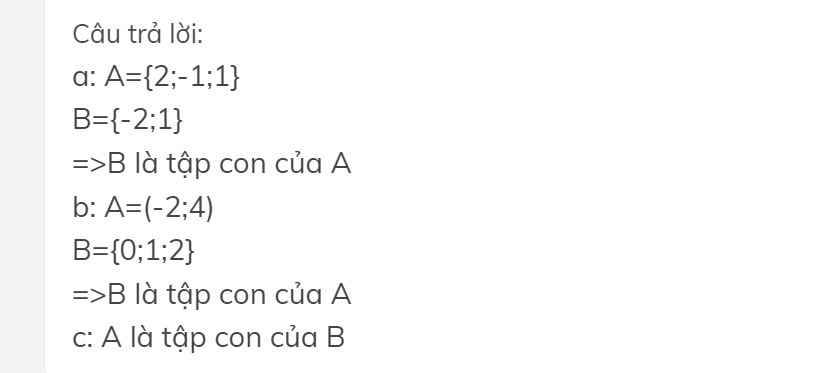Hãy nhập câu hỏi của bạn vào đây, nếu là tài khoản VIP, bạn sẽ được ưu tiên trả lời.

a: \(\left(2x^2-5x+3\right)\left(x^2-4x+3\right)=0\)
=>(2x-3)(x-1)(x-3)(x-1)=0
=>x=1; x=3;x=3/2
=>A={1;3;3/2}
b: \(\left\{{}\begin{matrix}x+3< 2x+4\\5x-3< 4x-1\end{matrix}\right.\Leftrightarrow\left\{{}\begin{matrix}-x< 1\\x< 2\end{matrix}\right.\Leftrightarrow-1< x< 2\)
mà x là số tự nhiên
nên B={0;1}

a, A k là con của B ; B k là con của A
b, A\(\subset\)B
c, A\(\subset\)B

a: A={2;-1;1}
B={-2;1}
=>B là tập con của A
b: A=(-2;4)
B={0;1;2}
=>B là tập con của A
c: A là tập con của B

1) \(x\in A\Leftrightarrow x^2\le25\Leftrightarrow-5\le x\le5\) nên \(A=\left[-5;5\right]\).
2) \(x\in B\Leftrightarrow-4< x< 5\) nên \(B=\left(-4;5\right)\)
3) \(x\in C\Leftrightarrow x\le-4\) nên \(C=\left(-\infty;-4\right)\)


Lời giải:
$A=\left\{0; 1;2;3;4\right\}$
$B=\left\{3\right\}$
$C=\left\{1;3\right\}$
$D=\left\{x\in\mathbb{N}|x=2k+1, \forall k\in\mathbb{N}\right\}$
Như vậy:
$B\subset C\subset A$
$B\subset C\subset D$